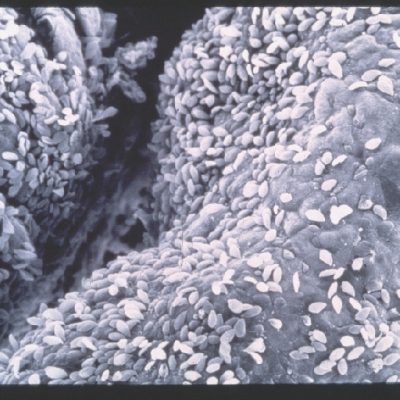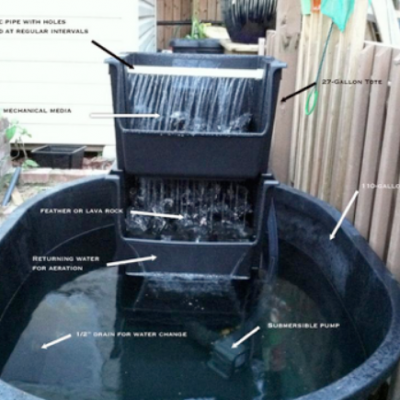The exhilaration of getting your most recent koi into its new home is tremendous—and somewhat terrifying too. Why? Because of bugs.
Bugs are everywhere. They are the undeniable and ever-present reality of a koi keeper’s life. Having bugs in your pond, and around your koi, is unavoidable.
Bacteria, viruses, parasites, fungus. The myriad of bugs come in many different guises and have some impressively long names, but the effect is all the same—illness, and sometimes death.
That is, of course, if they are allowed to run wild.
If you have koi, you have bugs. It’s simple as that. Whether you like it or not, bugs are part of the package of owning koi. Your koi swim through a cocktail of microscopic wildlife that is both helpful and potentially harmful. And the balance between the two poles is fine margins.
Now, not all bugs are looking for mischief, but those opportunistic pathogens can wreak havoc on a koi population when they’re in big enough numbers and in a favorable environment.
The job (a never-ending job, as many koi kichi will tell you) is to control the number of those opportunistic bugs by making your pond as inhospitable as possible.
Clean water, good parameters, and a functioning and well-maintained filtration system are all factors that help to ensure a healthy immune system. These are all things that the average bug cannot abide. A healthy pond keeps bugs in small numbers and makes damage to your Living Jewels less likely.
To help identify and treat some of the more common bugs, check out our post How to Recognize and Treat Common Koi Fish Illnesses.
Koi Bugs Aren’t Picky

It is important to note that bugs really aren’t all that fussy.
Whatever bugs that are already in the pond will go after anything new, and whatever is introduced into the pond has no problem looking for a foothold in anything that has been there for a while.
It doesn’t really matter what condition your pond is in, either. In an article we wrote, Koi in a Bubble, we discussed how old and unmaintained ponds—even if they are in a less-than-ideal condition—can still sustain koi.
A static and stable environment means the koi living in it will continue as normal (whatever that normal is)—as long as no new stressors are introduced (i.e. new bugs).
A new koi introduced to that system can disrupt that fragile balance and send it spinning out of control—even if those new koi have gone through preventative quarantine protocols.
And it happens in reverse too. Without koi manifesting signs of bug infestation, koi owners will introduce a new, properly quarantined koi into what they understand to be a well-regulated pond environment, only to watch that new koi die.
In the wild, natural conditions provide their own checks and balances on bugs. A koi keeper’s pond, for the most part, is a closed system that has to be continually maintained and maintenanced. If it isn’t, conditions abound that make it easy for opportunistic pathogens to gain a foothold.
An Ounce of Prevention, A Pound of Cure
If you don’t think you can afford to quarantine, wait until you see the bill for starting all over again.
The bigger your fish get, the more you invest in your pond, and the more attached you become to your koi, the more devastating a loss will become. The financial and emotional fallout of not properly preventing illness or disease can be significant.
That’s why we, as dealers, and dealers that offer one of the best money back guarantees in the industry even after following stringent quarantine protocols, STILL advise that everyone we send our fish to should put them through adequate quarantine.
We often hear that “we don’t have the space/facilities/money to be able to set up a quarantine tank.”
A quarantine tank doesn’t need to be a large or elaborate setup. It is simply a place for a koi to build up its immune system, adapt to a new environment or convalesce.
This quarantine tank setup cost $250 to make. That’s from soup to nuts. And its footprint isn’t huge (39” W x 58” L) either.

A quarantine tank can be as simple as a decent-sized aquarium. Just ensure that the dimensions of the tank are sufficient for the largest koi that you have should you need to remove it from its regular home. It will need to have adequate filtration, too. Koi create a lot of waste and need a robust filtration system to help maintain good water parameters.
Some Standard Quarantine Suggestions
Here are some basic tips for quarantining your new koi and helping to lessen the likelihood of bugs.
Duration
The standard quarantine period for koi owners is 30 days. This time frame matches the life cycle of some of the bugs that your koi might have. Gill fluke eggs, for example, can take up to 30 days to hatch in cooler temperatures, so even after you have “gotten rid” of the flukes, fluke eggs can hatch and reinfect the koi outside of the quarantine tank.
Canary Koi
Moving a “seasoned veteran” koi from your pond into the quarantine tank as a “welcome wagon” for your new koi has a couple of benefits:
- If you have only bought one koi, it helps for socialization
- Any bugs that are already in your pond can be identified
- Any new bugs on the incoming koi will register on the canary koi
- If there is indeed an issue, the potential loss of life and hassle of a pond-wide treatment is minimized drastically.
Know Your Volume
This is critical to the success of any quarantine effort. All the chemicals that you add to your pond will be expressed in a ratio. If you don’t accurately know the volume of water in your pond, you might add the wrong amounts. This in turn means:
- You will not add enough, thereby not fully eradicating the bug in question
- You add too much, resulting in potential damage to, or death in, your koi population
Both of these scenarios are dangerous or lethal to the koi whose immune system you are looking to boost. Your koi’s ability to fight off the bugs that are causing the problem is compromised or the excess chemicals poison it.
Feeding
Getting used to a new environment is stressful for a koi. Lack of appetite is one of the side effects of stress.
Feeding smaller than usual amounts means introducing less potential waste into the quarantine tank.
Temperature
Many of the bugs that afflict koi manifest themselves, and are more virulent, at higher temperatures. Keep the temperature at 70ºF or higher.
Additionally, as a poikilothermic creature whose body temperature is regulated by the ambient temperature of its environment, a koi’s immune system operates better at higher temperatures.
In some instances, you might need to add a heater to the tank to regulate the temperature.
Salt
Salt is always a source of contention amongst koi keepers. Some believe in its capabilities, while others believe that it is not as effective as advertised.
Some of the benefits of raising the salinity are:
- Helps to build up slime coat (which helps to keep some of the bugs at bay)
- Adds electrolytes
- Improves oxygen uptake
- Improves gill functions
- Lowers osmotic pressure (helping koi to save energy when expelling excess water)
- Aids in lowering stress
If you decide to use it, make sure that you get the right type of salt. Evaporated sea salt minus any chemical additives (like chlorine or iodine) is the best option.
Also, the correct salinity percentage is important. Between 3 and 5 parts per thousand will help combat all manners of bugs in your pond and on your koi. However, the higher the salinity, the more likely it is that most of your aquatic plants will die, too.
Cover
Stressed or ill koi are more likely to jump. Wherever possible, make sure that your quarantine setup is covered, or you might find them lying next to it.
Pond Water
Filling your quarantine tank with water from your pond can be helpful in acclimating your new koi to the water conditions it will eventually enter.
Of course, nothing about koi ownership is ever a certainty. Because bugs are always part of the equation, you will never sterilize to the point where they will never be a threat. All of these actions are going to give your koi the best chance against the bugs and the disease or illness they bring. But a little prevention can go a long way in ensuring that bugs do not become an issue for your entire pond.


Thank you for the articles, very informative.